This guide will take you through the step-by-step installation procedures required for a successful infoRouter install and implementation. Please print all relevant documentation before proceeding with this installation and make sure to follow these steps and perform them in the order in which they are described.
Please Read All Documentation
Please make sure that you have downloaded the required reading material as indicated in the email you received from us.
Before you begin to run any setup program, please review the Server & Client Requirements document (infoRouter System Requirements - V8.x) to make sure that you have allocated resources that meet the minimum requirements for best performance.
Please make sure that your web server has the .NET 4.8 framework installed. You must also make sure that your server has all the latest patches for your OS.
Before You Begin the Implementation
Please make sure to verify that your server complies with the minimum requirements specified in the relevant guides below:
Important Check List Prior To Installation
1) Logon to the web server as “Administrator” or use an account that has full administration rights.
2) Make sure that IIS is installed and running.
3) Make sure that ASP.NET 4 has been enabled on your server.
4) Download the setup program (the download link will be sent via email) and double click to begin the installation.
5) Follow the on-screen instructions.
Run the Setup Program
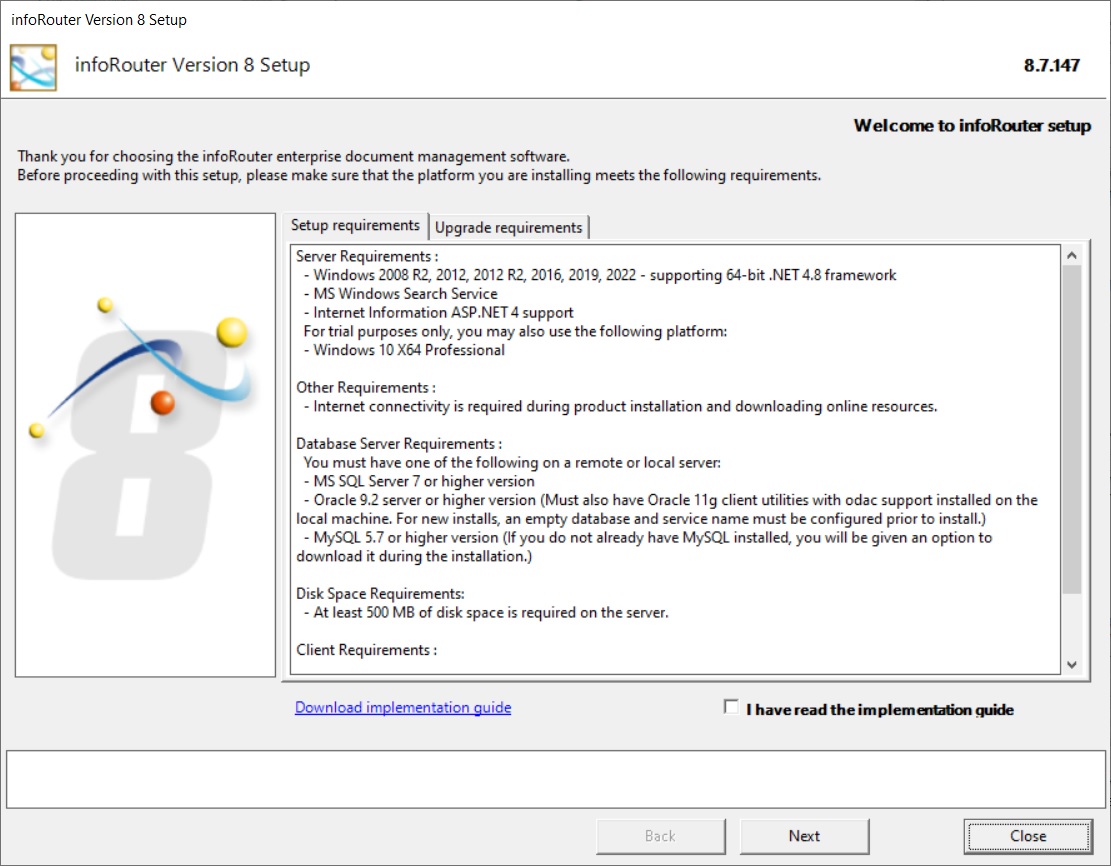
Click on the “Next” button to proceed.
Please wait while the Setup or Upgrade is checking the requirements.
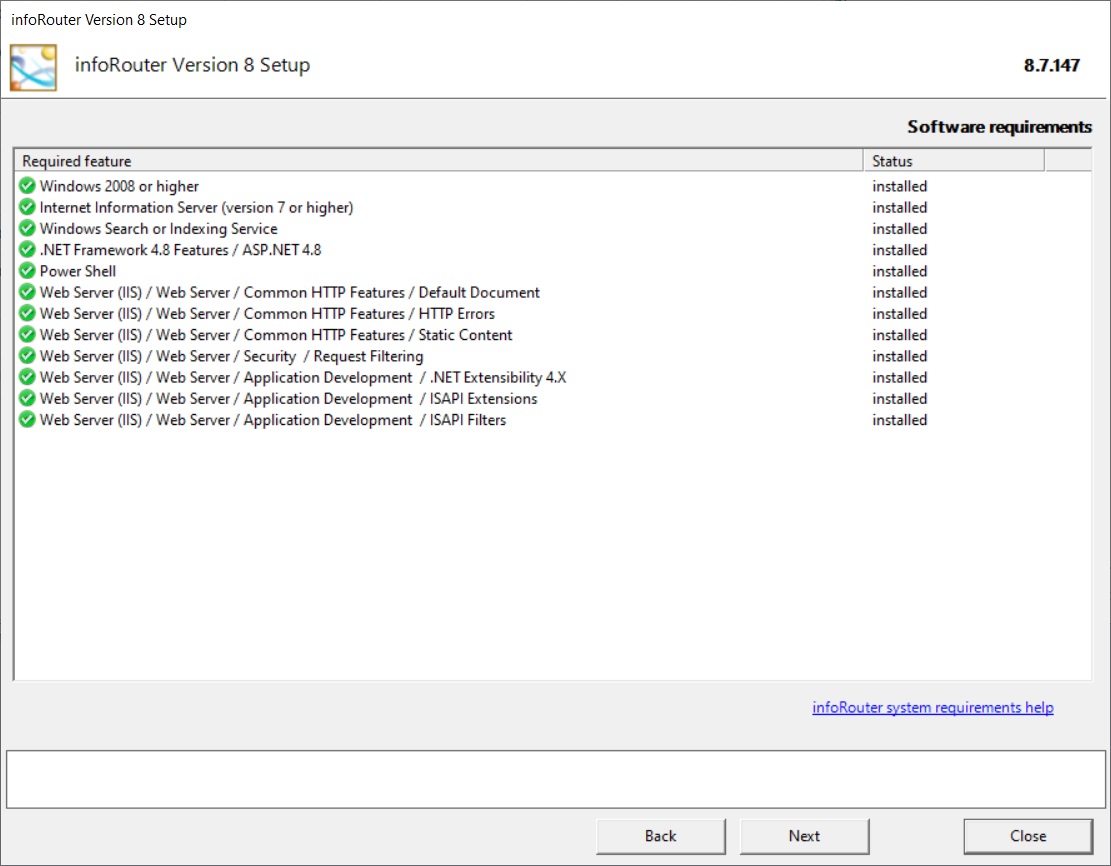
Click on the “Next” button to proceed.
Please Read The License Agreement
Please read the license agreement and check the “I Agree” checkbox to confirm that you have understood and accepted the license terms.
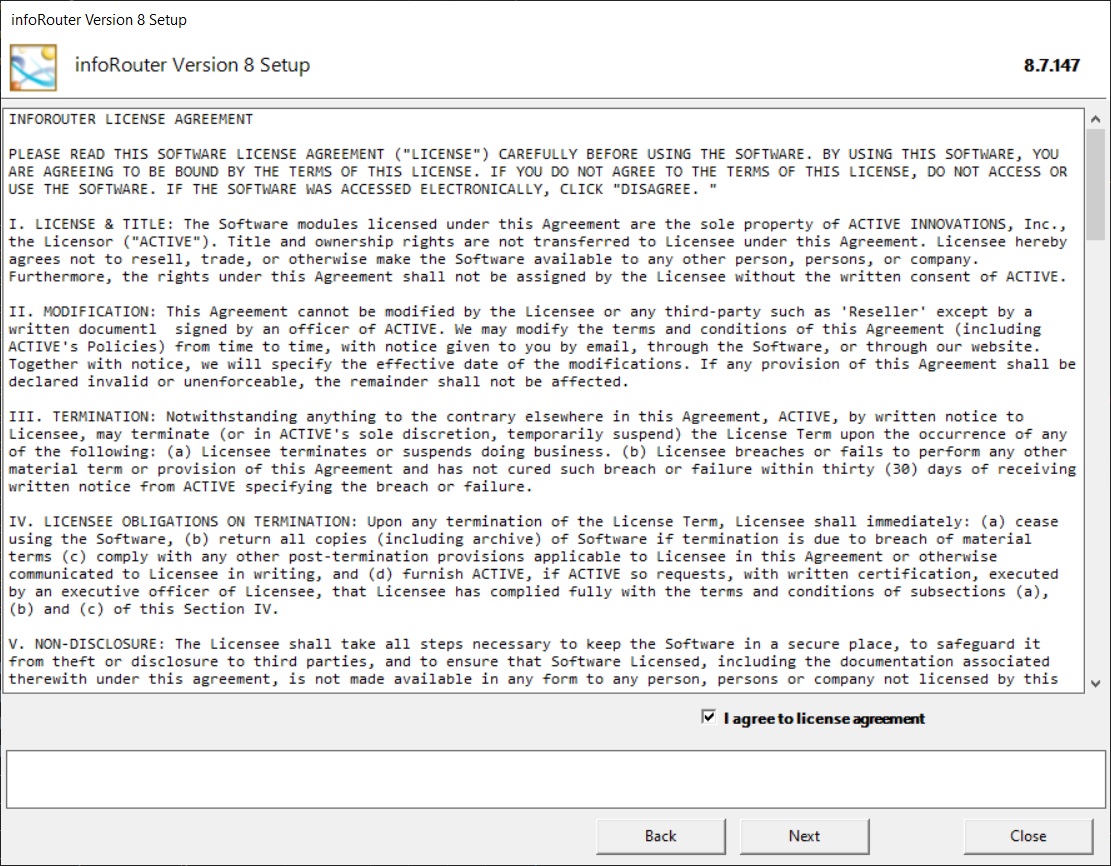
Click on the “Next” button to proceed.
To see the full infoRouter license agreement, click here
Setup / Upgrade Check
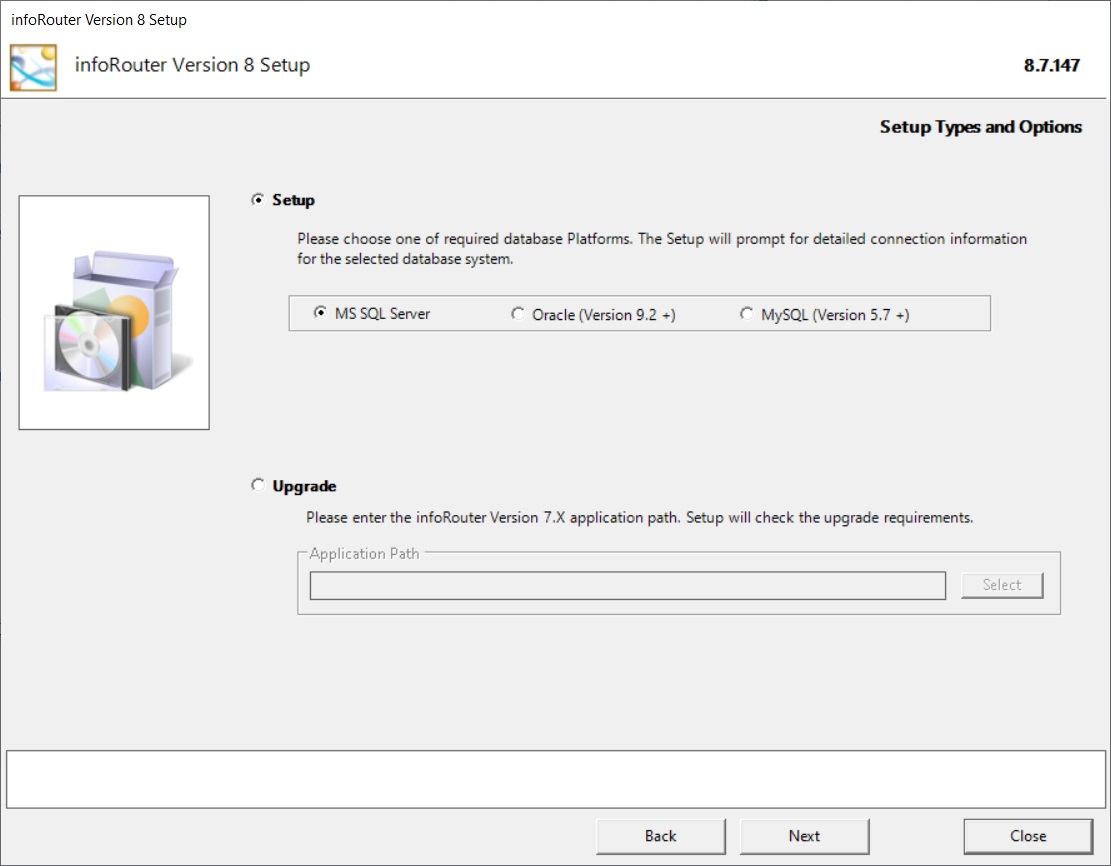
If you choose “Setup” option, you must choose the database platform you wish to use with infoRouter. Make your selection by clicking on the appropriate radio button.
Please be prepared for database setup section, you will specify the following:
- Server name on which the database is located
- User ID and Password for an account with appropriate rights to create a database or update an existing database
- Name of the database to be created or used
Click on the “Next” button to proceed.
Register Your License
Select your license file, which was provided to you with the download instructions.
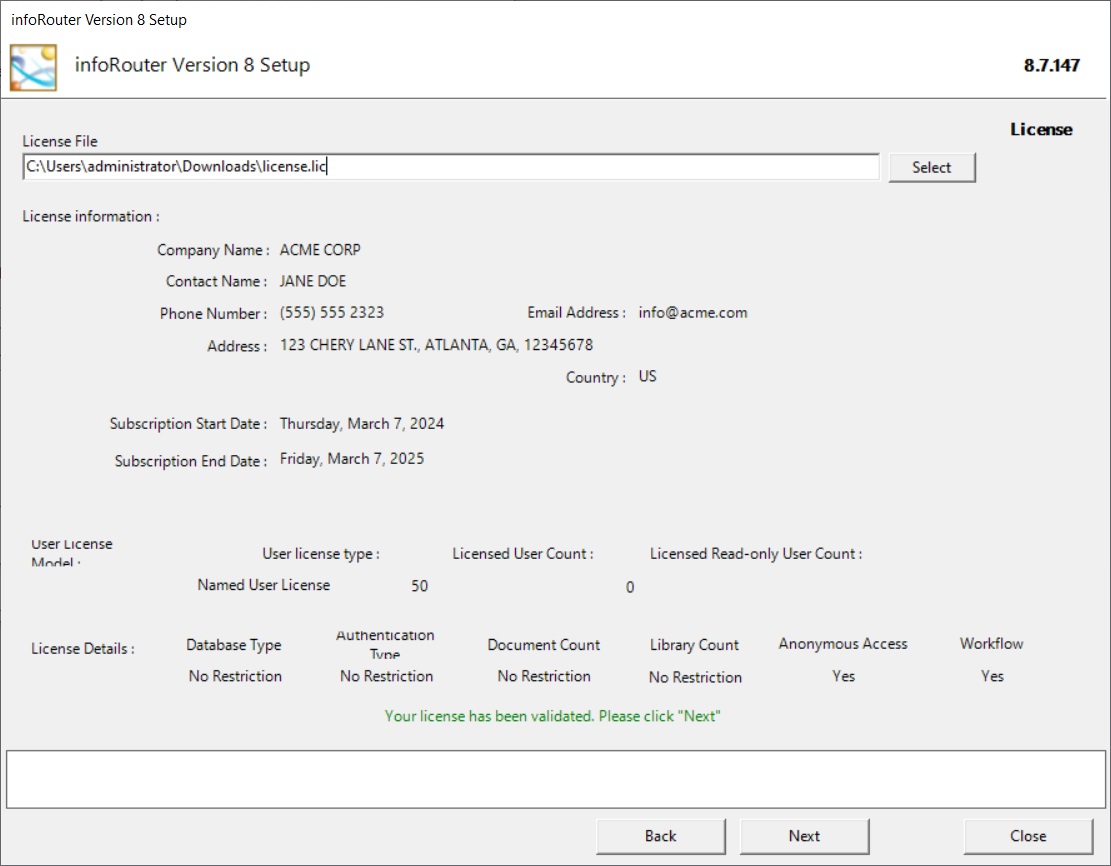
If you get an error stating that the license is invalid, please make sure that the license.lic file permissions have been appropriately set. Copying the license file on to the desktop or a folder on your workstation may change its security and the setup program may not be able to read this file.
If this is the case, simply change the security on the license.lic file to allow “Read” for “Everyone”.
Specify Installation Paths
A series of default paths will be provided. Either confirm the default installation paths or choose new paths. We strongly recommend taking the default values where possible. Remember, you will be able to change these later on.
Please do NOT choose a root folder such as C:\ or D:\ for the application path.
Please do NOT choose a root folder such as C:\ or D:\ for the warehouse path.
You may choose either MS Windows Search or MS Index Server.
Windows 2012 and beyond only supports MS Windows Search.
Windows search is the new generation search engine on Windows platforms. Microsoft no longer delivers MS Index Server on these new platforms. By default infoRouter uses MS Windows Search and no setting is required for this option.
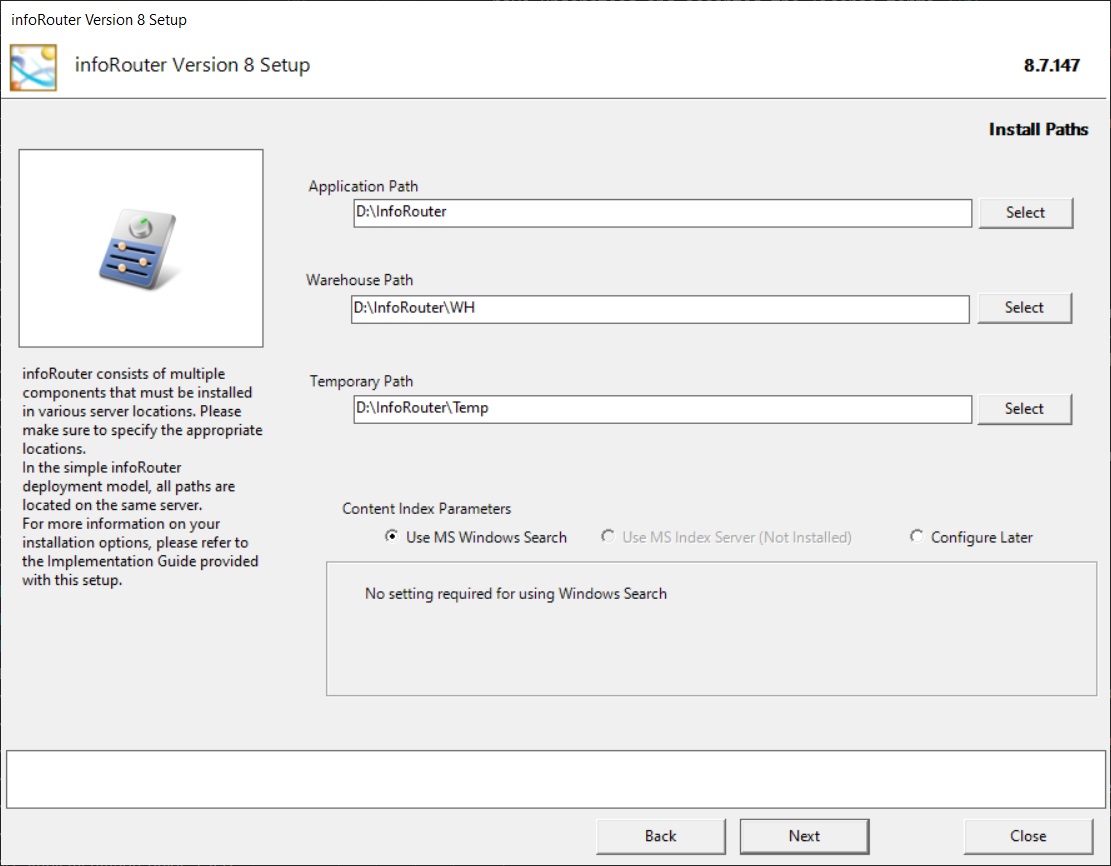
Database Setup
This screen demonstrates the setup when an existing MySQL instance is chosen. Please make sure that the version of the MySQL instance complies with the requirements document.
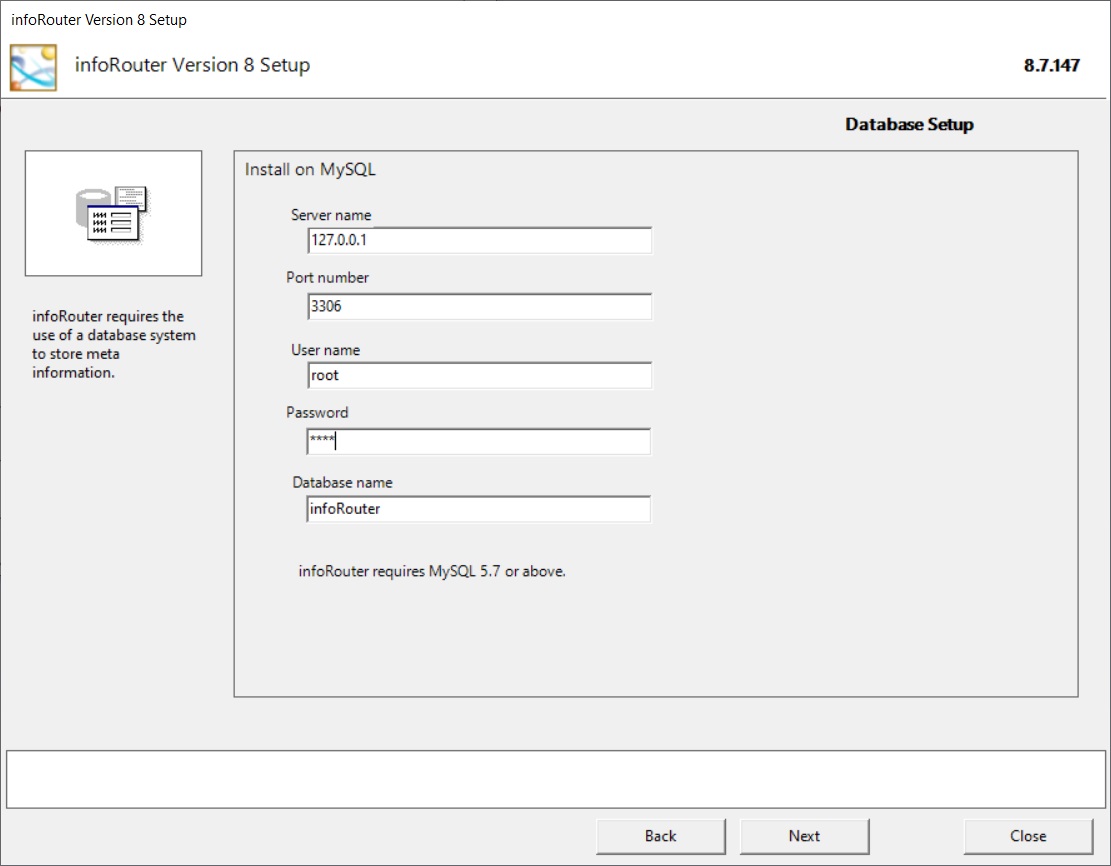
Installing on an old unsupported version or installing on a version of MySQL higher than the recommended version (including Beta versions) will create problems going forward. So please take the time to verify the version of MySQL before you go any further.
Notice that if you choose to install infoRouter to use MySQL, this screen provides a link from where you can download and install MySQL. If you do not already have MySQL installed, click on the “MySQL Download page” link before proceeding with the setup.
The latest version of MySQL that has been verified to work with infoRouter is MySQL Version 8.0.28 .
The following screen describes the Oracle database selection
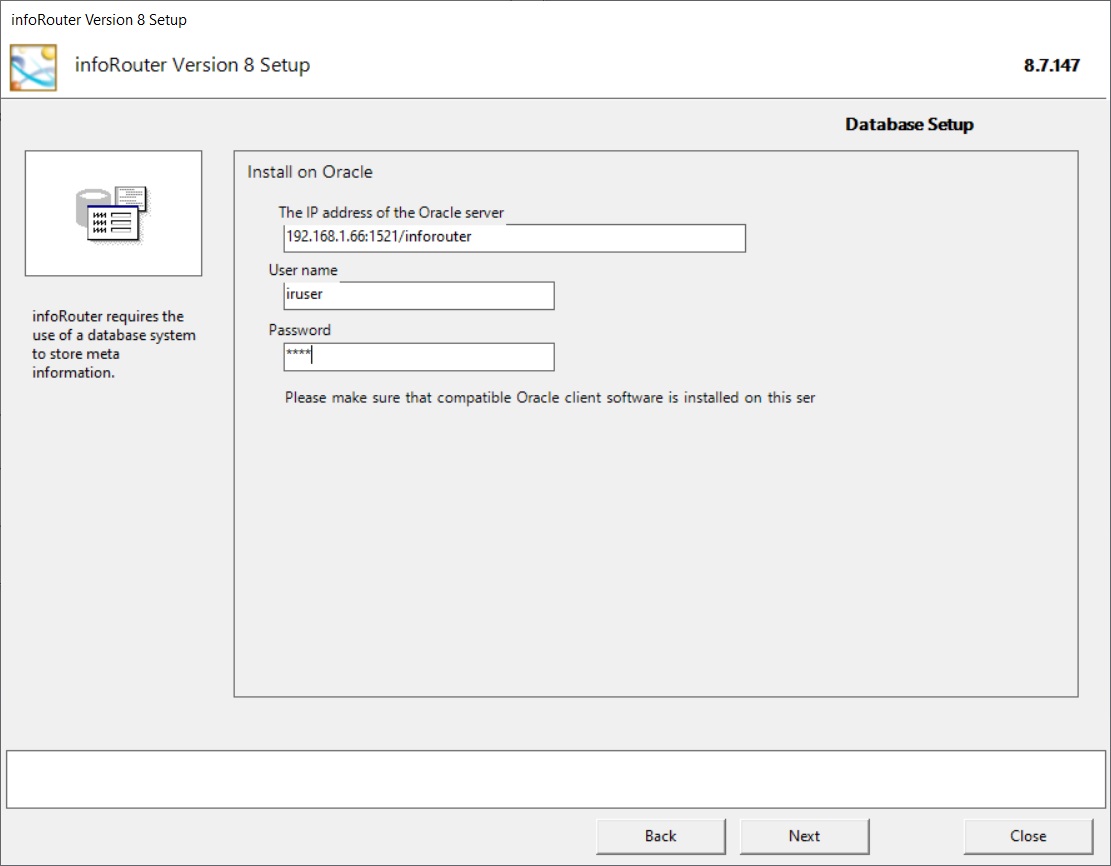
Using Oracle as your database platform requires a previously installed and working Oracle Database Server, minimum Oracle 11g client on the infoRouter server and an existing database allocated for use by infoRouter.
Enter the Oracle Service Name and User Name & Password combination for a user authorized to manage the previously created database.
The following screen describes the MS SQL database selection
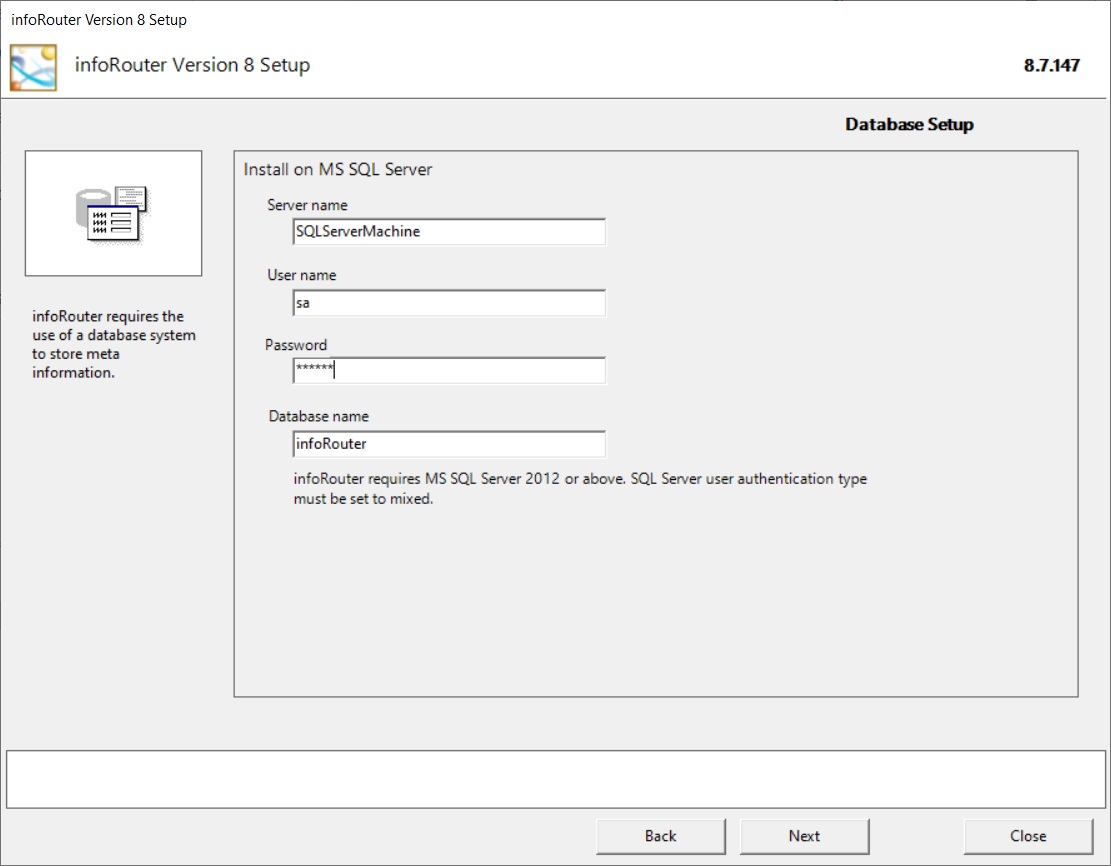
Using MS SQL Server as your database platform requires a previously installed and working MS SQL Server instance.
Enter the server name or (local) and a User Name & Password combination for a user authorized to manage the previously created database. Then specify the database name (usually infoRouter).
Web Site And/Or Virtual Directory Settings
If you would like to use a web site instead of a virtual directory, select the previously created web site name from the IIS Web Sites List and choose “Create infoRouter application as selected Web site” option.
Alternatively, you may choose to have the setup program create a virtual directory for you.
We recommend using the default name of infoRouter..
Make sure that the “Fully Qualified URL” is accurate and it reflects your server name.
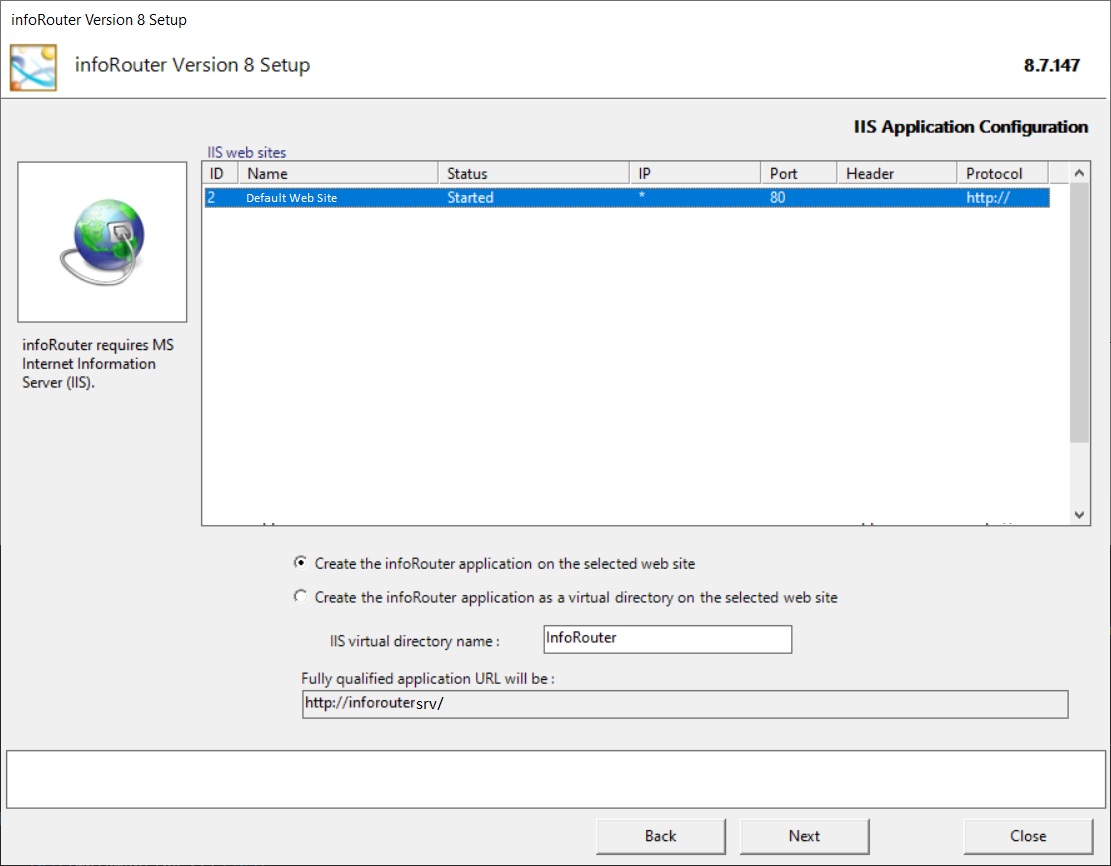
Implementing SSL
infoRouter can run in HTTPS mode and this is generally transparent to infoRouter. However, we recommend implementing infoRouter in the regular HTTP mode during the initial install. Once the initial installation is successfully completed, SSL should be implemented as a second step.
Please refer to the SSL section at the end of this document to make the required changes.
SMTP Configuration
Change the “System Email Address” by changing the “[your domain]” with your company domain name. The system email address is a dummy email address that will be used by infoRouter to send SMTP email notifications to infoRouter users.
Remember, this email address will not be able to receive emails from users.
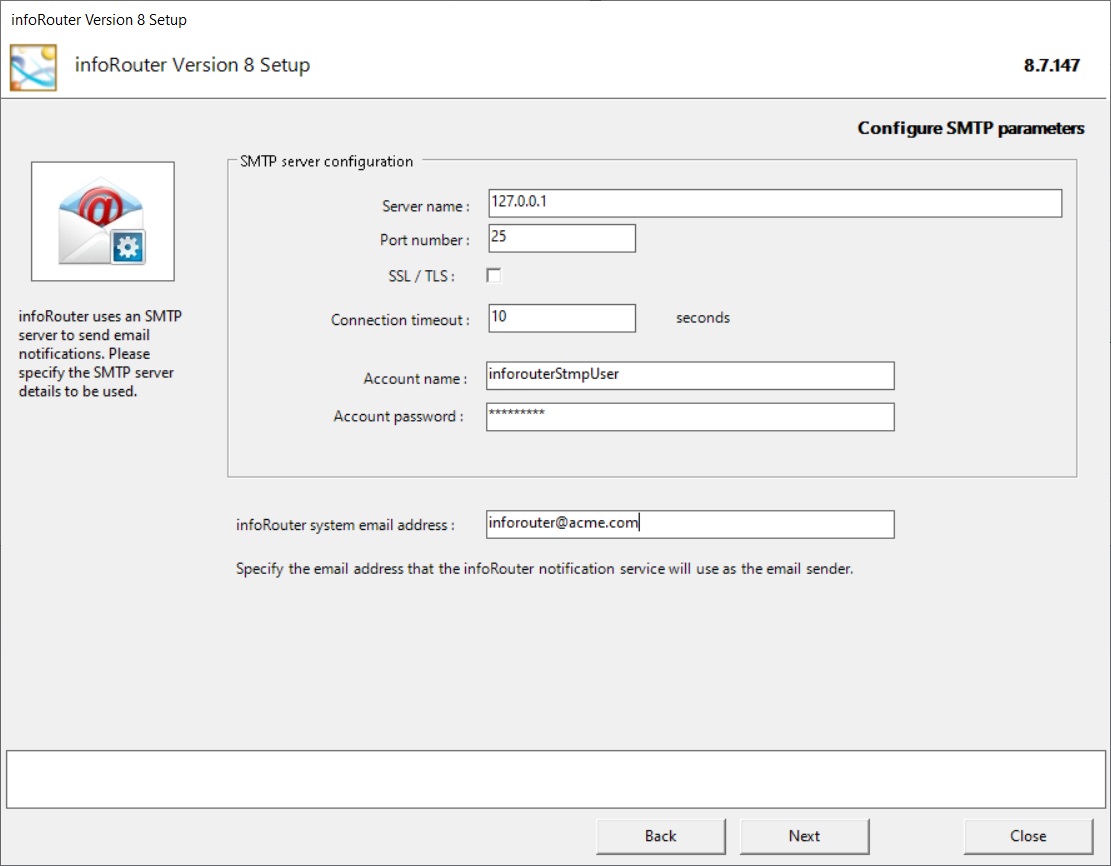
Please make sure that the SMTP server you wish to use is configured to allow relay from the infoRouter server. If the SMTP server does not require an account name but you specify this information in the screen above emails are likely to fail.
If you find that you cannot send emails from infoRouter after the implementation, please refer to the SMTP Troubleshooting Guide
Specify The "SYSADMIN" Account Password
In this screen, you must specify a password for the “SYSADMIN” account. Please choose a password that is hard to guess but something you can remember. Make a record of your password in a safe place.
If you do forget your password, you may navigate to the HELP tab from any portal and click on the “Forgot Password” link. Enter your an email address and infoRouter will send you your password to the specified email address. The “Forgot password” option is only available after a successful install of infoRouter. Therefore, it is important to specify a valid email address for the “SYSADMIN” account.
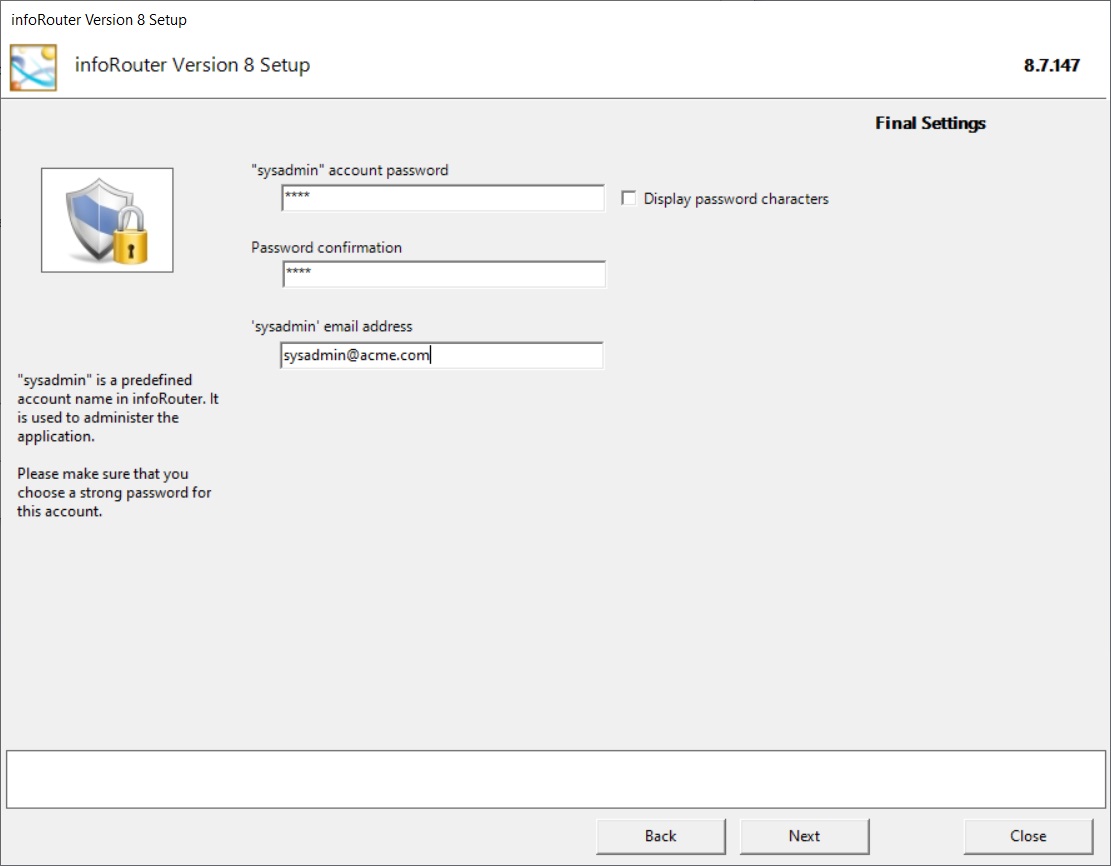
Note: The SYSADMIN password is set to “pass” (in lowercase) by default. If you are installing the DEMO PACK, all pre-defined user passwords are also set to “pass”.
Finish Install
Click the Finish Button to Install

If you have selected MS SQL Server or MySQL, the setup program will create the infoRouter database if one does not already exist. For Oracle, you must have an existing infoRouter database.
At this stage of the installation, the setup program will need to access the database specified in the previous step.
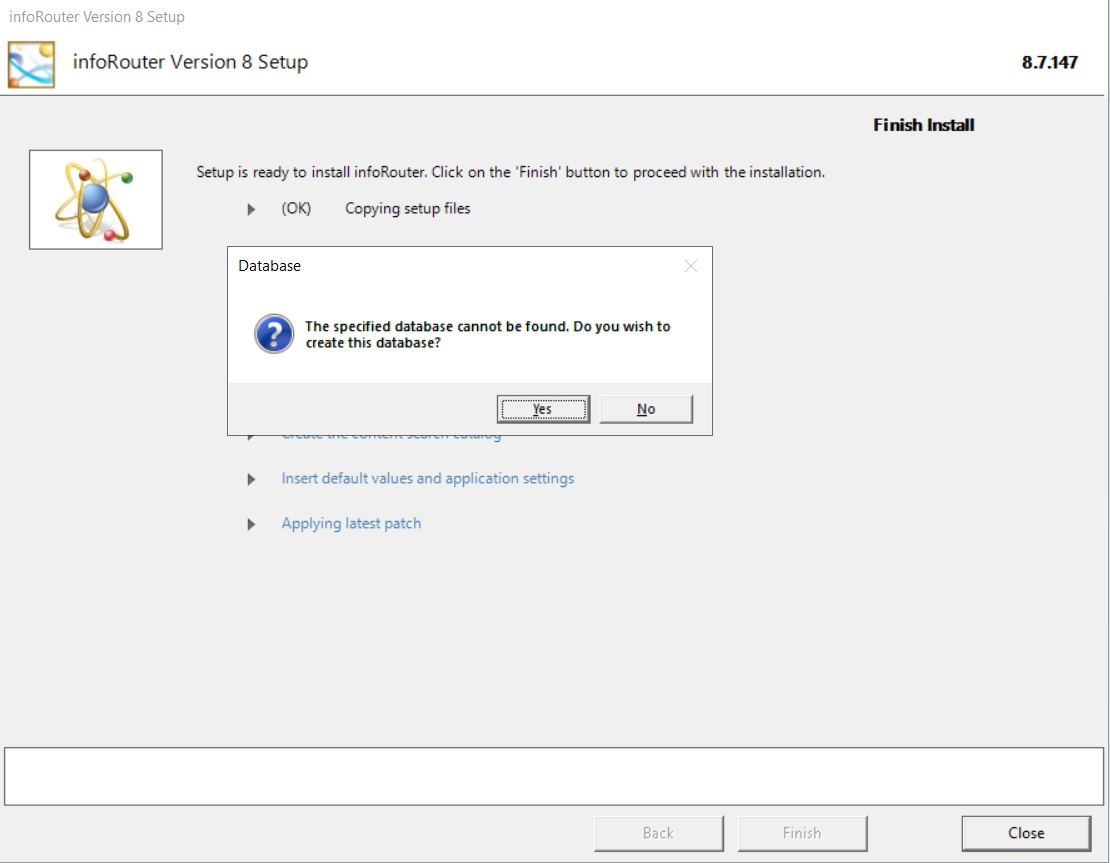
If the specified database does not exist, the setup program will confirm that a database does not exist and one is going to be created for you (MS SQL Server and MySQL only).
Installation Is Complete
At this screen, the setup of infoRouter is complete and the setup program will attempt to launch infoRouter.
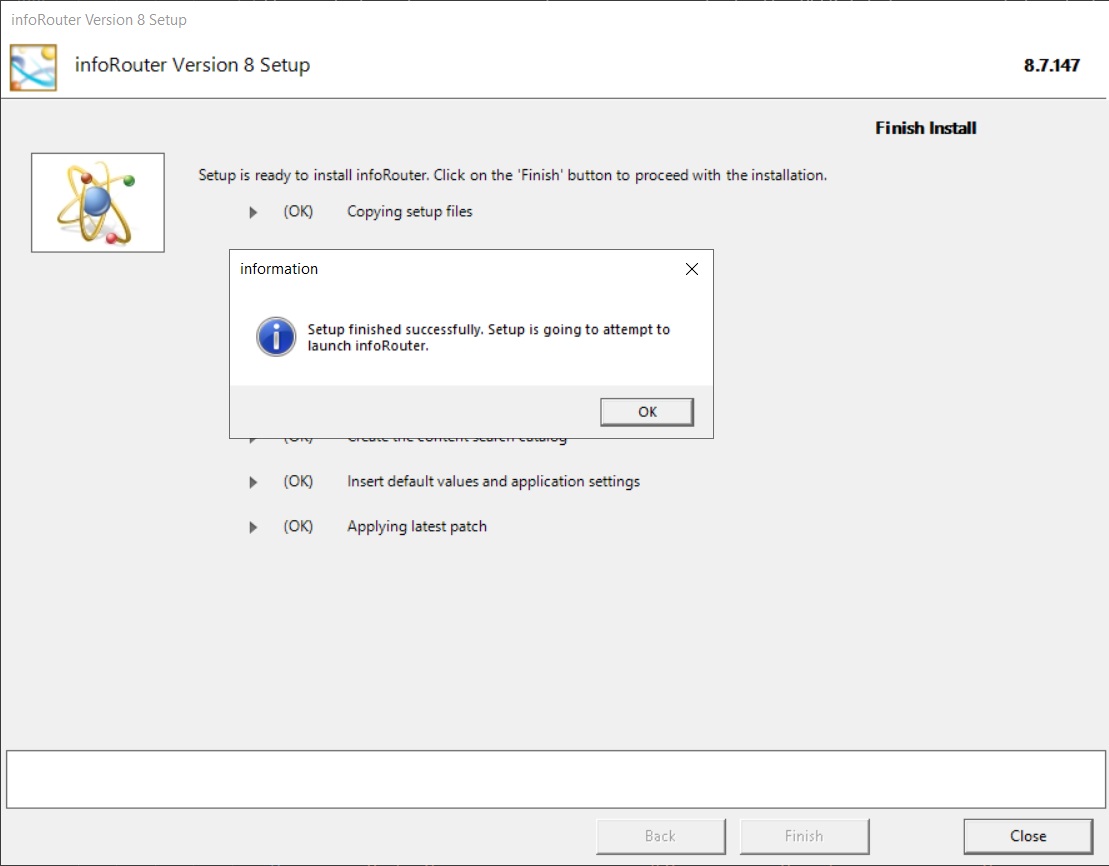
Logging on to Inforouter
Once the setup is complete, the setup program will automatically launch infoRouter.
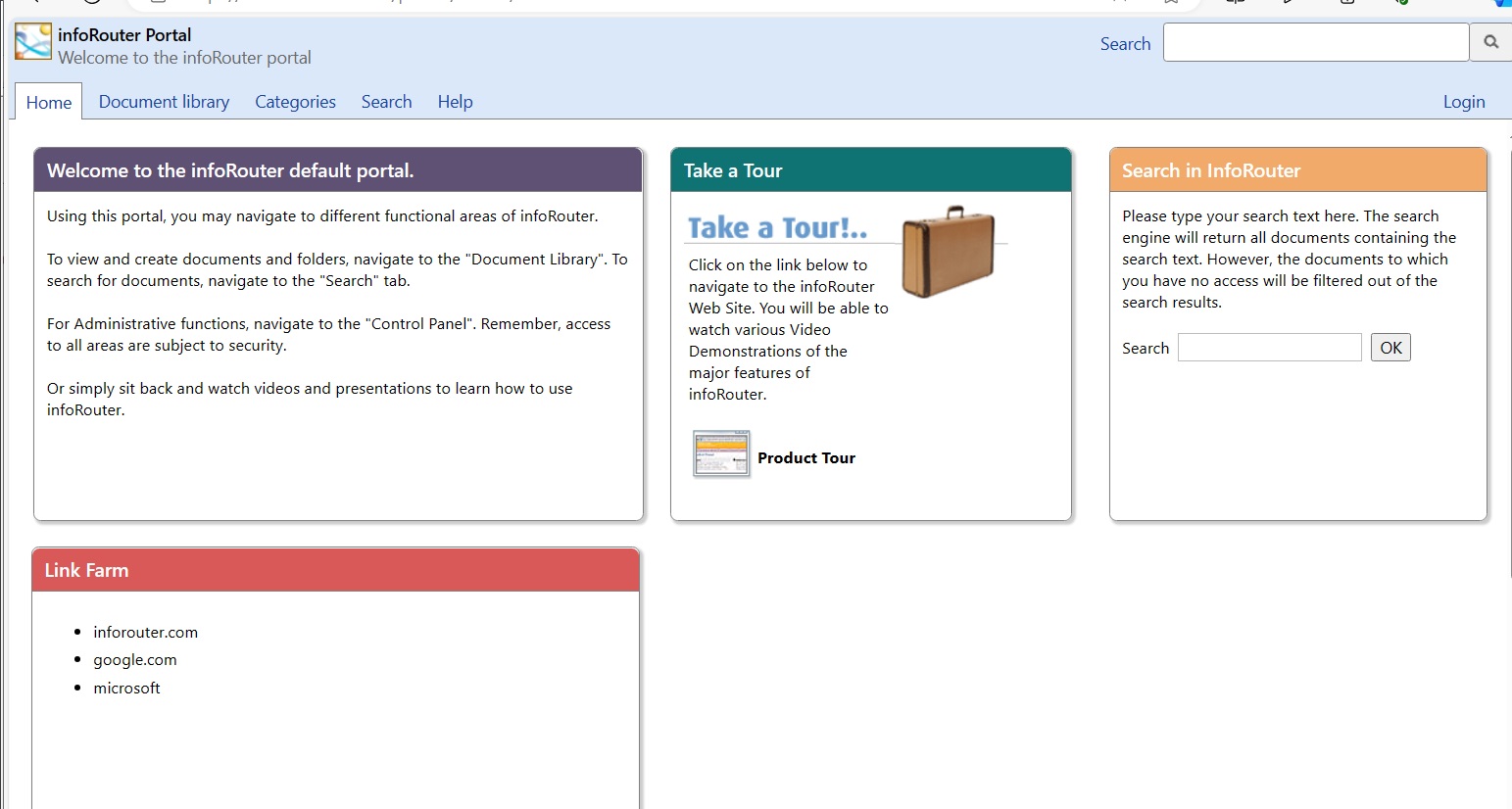
Click on the “Member Login” button located on the upper right corner of the browser window to log into infoRouter.
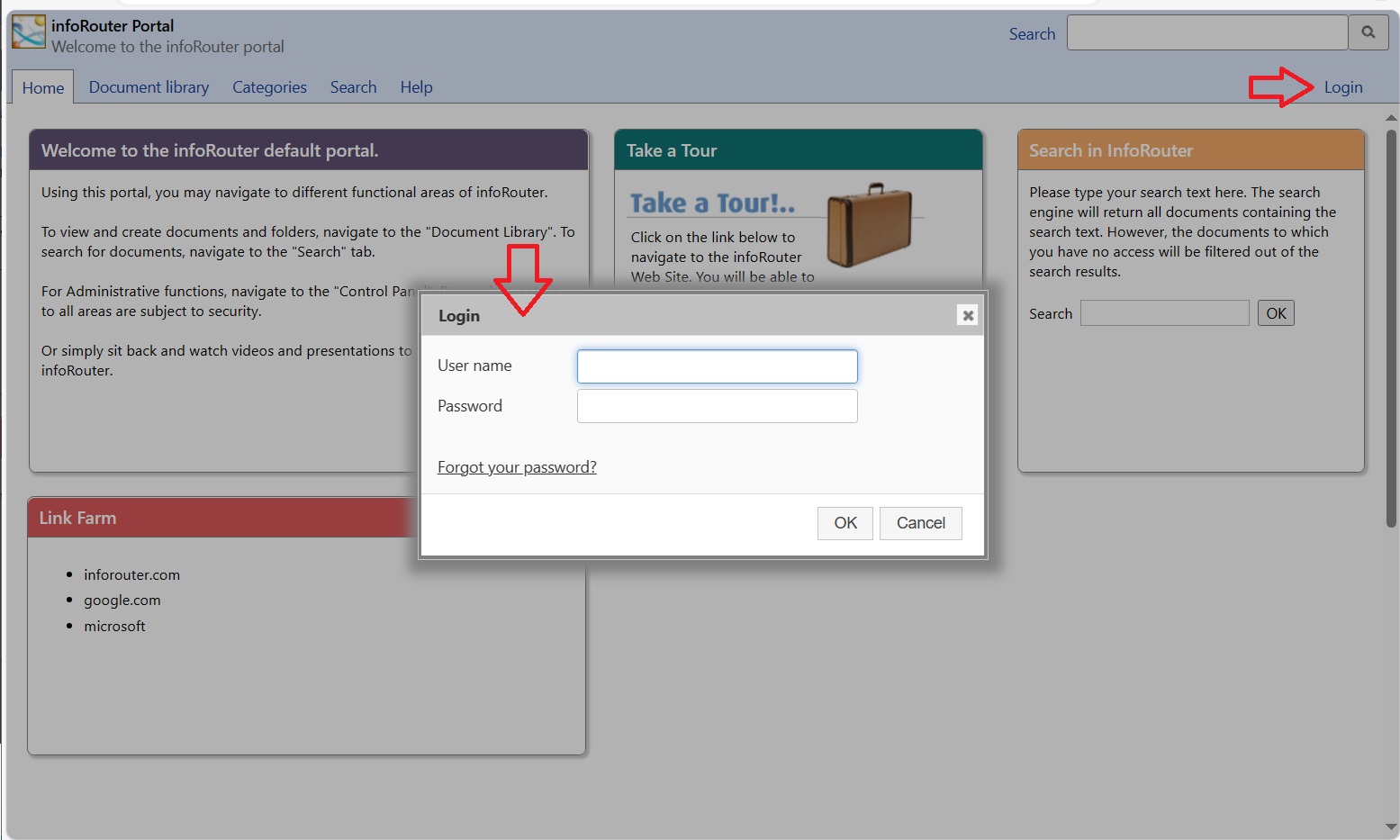
During the setup, the only application user is being configured is "sysadmin" account which has administrative rigths by default.
Remember, the sysadmin password is defined while the application is being setup.
Install Additional Ifilters
Now that the installation of infoRouter is complete, the only remaining task is to provide MS Index Server / MS Windows Search additional tools to help you find documents quickly and easily.
By default, MS Index Server / MS Windows Search is able to perform full-text searches on all documents produced using MS Office Products (MS Word, MS Excel, MS PowerPoint) and other text based document formats such as HTML, Text and XML. (IFilters for MS Office 2007 and 2010 file formats (.docx, .xlsx, .pptx) can be downloaded from Microsoft.
If you would like to have MS Index Server / MS Windows Search perform full-text searches on additional document types and formats, you must install additional software called iFilters on your server. We have provided a selection of iFilters we know to be free. You can install these on your server to extend the power of MS Index Server / MS Windows Search beyond the indexing office products.
These can be found in the infoRouter install directory. The iFilters can be located under infoRouter>ProgramSetups>iFilters.
If you need iFilters for additional file formats, there are a number of third-party companies that develop them.
Ifilters Installation Is Complete
Congratulations, the setup is now complete.
Please refer to the “Administrator’s Getting Started Guide” to get started with the configuration of infoRouter for production use.
Security Requirements for Single & Distributed Model Installations
If you choose to use the Distributed Model, you must perform the following:
If you wish to place some or your entire warehouse on a machine other than the IIS machine, you must use a domain account as your IIS user. To do this, you must configure the Web.config file located in the installation directory (C:\infoRouter\Site).
To configure this file, open the "Web.config" file using Notepad.
Add the following line in <system.web> section.

Specify the DomainName, UserName and the Password of the Domain User account.
Important Note: The domain account chosen for impersonation should be added to the “Users” user group for the local machine (IIS Machine)
Please note that editing and saving of the web.config file causes the infoRouter application to restart.
NT Level Security Requirements
The domain account specified in the Web.config file must have the following access permissions to the following paths.
Network Service" account must have the same permissions
Warehouse Folder Full Control infoRouter installation directory Full Control (c:\inforouter by default) Windows Temp directory Full Control InfoRouter Temp directory Full Control (Specified in the application settings, by default c:\inforouter\temp)
Important Notes About Impersonation
The specified user account chosen must be able to access all the defined paths for your warehouse. These paths should not be shared. All changes to the documents must be made by infoRouter.
Do not limit access rights to the defined paths for the local user account.
Do not apply read/write permissions to directories in the warehouse paths.
If you wish to use remote paths (UNC paths) for storage, you must make sure to use a domain account and NOT a local account. Since local accounts are by definition only valid on the machine in which they are defined, these accounts cannot be assigned privileges on remote paths or servers.
If you choose to use the Simple Model, you must perform the following:
If your warehouse resides on the same server as the IIS machine, you do not need to use impersonation.
NT Level Security Requirements for Windows server machines:
The NETWORK SERVICE should have the following access permissions to the following paths:
Warehouse Folder Full Control infoRouter installation directory Full Control (c:\inforouter by default) Windows Temp directory Full Control InfoRouter Temp directory Full Control (This is a parameter in the application settings window)
Other Important Considerations & Restrictions
In the “Distributed Mode”, you can split your warehouse entries among different drives on the network however; you may NOT use mapped drives.
Mapped drives are user specific.
Example:
You log into the server as “Joe”
You create a mapped drive called “Z” and point it to a network drive.
As long as you log into this server as “Joe”, the mapped drive will be available. As soon as you log out and log in as someone else, the mapped drive will no longer be available.
Result:
If you create a mapped drive and reboot your server (and do not log in as “Joe”), the mapped drive will no longer be available to infoRouter therefore making part of or the entire warehouse inaccessible.
Use UNC Paths instead:
UNC paths are fully qualified paths that are system specific and do not depend on any logged in user
//NetworkServerName/DriveName.
For more information on using infoRouter in the distributed mode, please refer to the Distributed-vs-SimpleModel-V80 document.
Implementing SSL
Implementing SSL is out of the scope of this document and is not a support service we provide. If you intend to use SSL, you must purchase a real certificate from one of the few certificate providers in the marketplace and apply it to the IIS server on which infoRouter runs.
Once this is done and is tested to be in working order, you must make a few changes in two infoRouter configuration files.
1) Change the “Application URL” parameter in the infoRouter Web.config file. Example: http:/server_name/infoRouter must be changed to https:/server_name/infoRouter 2) Change the infoRouter Web Service URL in the IRMaintenance.config file. Example: http:/server_name/infoRouter/srv.asmx must be changed to https:/server_name/infoRouter/srv.asmx
The infoRouter web.config file can be found in a sub-folder called “site” in the infoRouter application directory.
Examples:
C:\inforouter\site\web.config
or
D:\inforouter\site\web.config
The infoRouter IRMaintenance.config file can be found in a sub-folder called
“IRMaintenance” in the infoRouter application directory.
Example:
C:\inforouter\IRMaintenance\IRMaintenance.config
Backups And Ongoing System Maintenance
Backup Strategy:
You must have a backup strategy for infoRouter. Please read and implement the recommendations outlined in the Backup Restore Disaster Recovery Guide In the event of a hardware failure or disaster, your backups may be the only source of recovery.
You are responsible to keep regular and verified backups of the system as described by the document mentioned above.
infoRouter System Maintenance:
You must also have a strategy for system maintenance. Active Innovations makes regular announcements for new releases and patches. These announcements are sent to the technical contact we have on file for you. Please read these announcements and perform the requested actions to make sure your system is kept up to date with the latest version of the software.
A system administrator must be designated to perform regular system maintenance tasks such as running Live Updates, maintaining the infoRouter system recycle bin, managing users etc.
Please download the required documentation from our support site and check back regularly for updated documentation.
Required Reading:
infoRouter Administrator's Guide V8.x
Operating System & Database System Updates and Patches:
To effectively manage the operating system and database system updates and patches for infoRouter, consider the following tasks:
- Regular Monitoring: Keep a vigilant eye on updates and patches released by your system vendor for the operating system and database platforms.
- Timely Application: Ensure prompt application of patches to the operating system to maintain security and stability for infoRouter.
- Dedicated Maintenance Staff: Designate dedicated or part-time staff members specifically responsible for maintaining the underlying operating systems and database platforms.
- Training and Resources: Provide necessary training and resources to the maintenance staff to enable them to effectively handle updates and patches.
- Manual and Automated Maintenance Jobs: Create and implement both manual and automated maintenance jobs to keep the systems running smoothly. This could include tasks such as database optimization, disk space management, and performance monitoring.
- Documentation: Maintain comprehensive documentation of update and patch procedures, including schedules, responsibilities, and any specific requirements for infoRouter compatibility.
Note: Active Innovations does not offer support for underlying operating systems or database platforms.
By adhering to these tasks, you can ensure that the operating system and database systems supporting infoRouter remain up-to-date, secure, and optimized for performance.